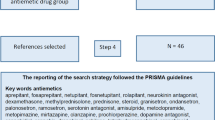Abstract
Purpose
Corticosteroids are commonly used to alleviate symptoms from cerebral vasogenic edema in glioblastoma (GBM) patients. This study evaluated the impact of overall corticosteroid exposure during chemoradiotherapy (CRT) on acute severe lymphopenia (ASL) and survival outcomes of GBM patients.
Methods
GBM patients treated with CRT from 2007 to 2016 were retrospectively analyzed. Overall corticosteroid exposure was estimated as the average daily dexamethasone dose during 6 weeks of CRT. ASL was defined as grade 3 or higher lymphopenia within 3 months of starting CRT. ASL rates, overall survival (OS), and progression-free survival (PFS) were analyzed using Kaplan–Meier method. Multivariable analysis (MVA) was performed using logistic and Cox regression to identify independent predictors of ASL and survival outcomes, respectively.
Results
Of the 319 eligible patients, the median daily dexamethasone use was 2 mg/day. The high-dose dexamethasone cohort (> 2 mg/day) had significantly higher ASL and worse OS than the low-dose dexamethasone cohort: 3-month ASL of 43.7% versus 19.8% (p < 0.003) and median OS of 12.6 months versus 17.9 months (p < 0.001), respectively. On MVA, higher dexamethasone use was independently associated with higher ASL and worse OS, but not worse PFS. A subset analysis of patients with gross-total resection found that higher dexamethasone use was significantly associated with ASL, but not OS.
Conclusion
Increased corticosteroid use among GBM patients during CRT appears to be an independent risk factor for developing subsequent ASL. Its apparent association with worse OS may be influenced by other confounding factors and would need to be validated through prospective investigations.


Similar content being viewed by others
Data availability
The datasets generated during and/or analyzed during the current study are available from the corresponding author on reasonable request.
References
Wen PY, Kesari S (2008) Malignant gliomas in adults. N Engl J Med 359(5):492–507
Porter KR, McCarthy BJ, Freels S, Kim Y, Davis FG (2010) Prevalence estimates for primary brain tumors in the United States by age, gender, behavior, and histology. Neuro Oncol 12(6):520–527
Stupp R, Mason W, Bent M, van den Weller M, Fisher B, Taphoorn M et al (2005) Radiotherapy plus concomitant and adjuvant temozolomide for globlastoma. N Engl J Med 352:987–996
Grossman SA, Ye X, Lesser G, Sloan A, Carraway H, Desideri S et al (2011) Immunosuppression in patients with high-grade gliomas treated with radiation and temozolomide. Clin Cancer Res 17(16):5473–5480
Mendez JS, Govindan A, Leong J, Gao F, Huang J, Campian JL (2016) Association between treatment-related lymphopenia and overall survival in elderly patients with newly diagnosed glioblastoma. J Neurooncol 127(2):329–335
Rudra S, Hui C, Rao YJ, Samson P, Lin AJ, Chang X et al (2018) Effect of radiation treatment volume reduction on lymphopenia in patients receiving chemoradiotherapy for glioblastoma. Int J Radiat Oncol 101(1):217–225
Huang J, Dewees TA, Badiyan SN, Speirs CK, Mullen DF, Fergus S et al (2015) Clinical and dosimetric predictors of acute severe lymphopenia during radiation therapy and concurrent temozolomide for high-grade glioma. Int J Radiat Oncol Biol Phys 92(5):1000–1007. https://doi.org/10.1016/j.ijrobp.2015.04.005
Lin AJ, Campian JL, Hui C, Rudra S, Rao YJ, Thotala D et al (2018) Impact of concurrent versus adjuvant chemotherapy on the severity and duration of lymphopenia in glioma patients treated with radiation therapy. J Neuro-Oncol 136(2):403–411
Chongsathidkiet P, Jackson C, Koyama S, Loebel F, Cui X, Farber SH et al (2018) Sequestration of T cells in bone marrow in the setting of glioblastoma and other intracranial tumors. Nat Med 24(9):1459
Chitadze G, Flüh C, Quabius ES, Freitag-Wolf S, Peters C, Lettau M et al (2017) In-depth immunophenotyping of patients with glioblastoma multiforme: impact of steroid treatment. Oncoimmunology 6(11):e1358839
Wong ET, Lok E, Gautam S, Swanson KD (2015) Dexamethasone exerts profound immunologic interference on treatment efficacy for recurrent glioblastoma. Br J Cancer 113(2):232–241
Pitter KL, Tamagno I, Alikhanyan K, Hosni-Ahmed A, Pattwell SS, Donnola S et al (2016) Corticosteroids compromise survival in glioblastoma. Brain 139(5):1458–1471
Deasy JO, Blanco AI, Clark VH (2003) CERR: A computational environment for radiotherapy research. Med Phys 30(5):979–985. https://doi.org/10.1118/1.1568978
Hughes MA, Parisi M, Grossman S, Kleinberg L (2005) Primary brain tumors treated with steroids and radiotherapy: Low CD4 counts and risk of infection. Int J Radiat Oncol Biol Phys 62(5):1423–1426
Sampson JH, Maus MV, June CH (2017) Immunotherapy for brain tumors. J Clin Oncol 35(21):2450–2456
Shields LBE, Shelton BJ, Shearer AJ, Chen L, Sun DA, Parsons S et al (2015) Dexamethasone administration during definitive radiation and temozolomide renders a poor prognosis in a retrospective analysis of newly diagnosed glioblastoma patients. Radiat Oncol 10(1):222
Sur P, Sribnick EA, Patel SJ, Ray SK, Banik NL (2005) Dexamethasone decreases temozolomide-induced apoptosis in human gliobastoma T98G cells. Glia 50(2):160–167
Gilbert MR, Dignam JJ, Armstrong TS, Wefel JS, Blumenthal DT, Vogelbaum MA et al (2014) A randomized trial of bevacizumab for newly diagnosed glioblastoma. N Engl J Med 370(8):699–708
Acknowledgements
The authors would like to acknowledge Dan Mullen and Sandra Fergus for their tremendous support in data management and acquisition of radiation dosimetric data.
Author information
Authors and Affiliations
Corresponding author
Ethics declarations
Conflict of interest
J.H. reports research support from Pfizer and Cantex, personal fees from Viewray, outside the submitted work. J.L.C reports research support from NeoImmuneTech Inc. and Incyte Corporation, outside the submitted work. The remaining authors declare no conflict of interest.
Ethical approval
All procedures performed in studies involving human participants were in accordance with the ethical standards of the institutional and/or national research committee and with the 1964 Helsinki declaration and its later amendments or comparable ethical standards.
Informed consent
Informed consent was waived for this study after evaluation of methodology by Institutional Review Board.
Additional information
Publisher’s Note
Springer Nature remains neutral with regard to jurisdictional claims in published maps and institutional affiliations.
Electronic supplementary material
Below is the link to the electronic supplementary material.
Rights and permissions
About this article
Cite this article
Hui, C.Y., Rudra, S., Ma, S. et al. Impact of overall corticosteroid exposure during chemoradiotherapy on lymphopenia and survival of glioblastoma patients. J Neurooncol 143, 129–136 (2019). https://doi.org/10.1007/s11060-019-03146-7
Received:
Accepted:
Published:
Issue Date:
DOI: https://doi.org/10.1007/s11060-019-03146-7




